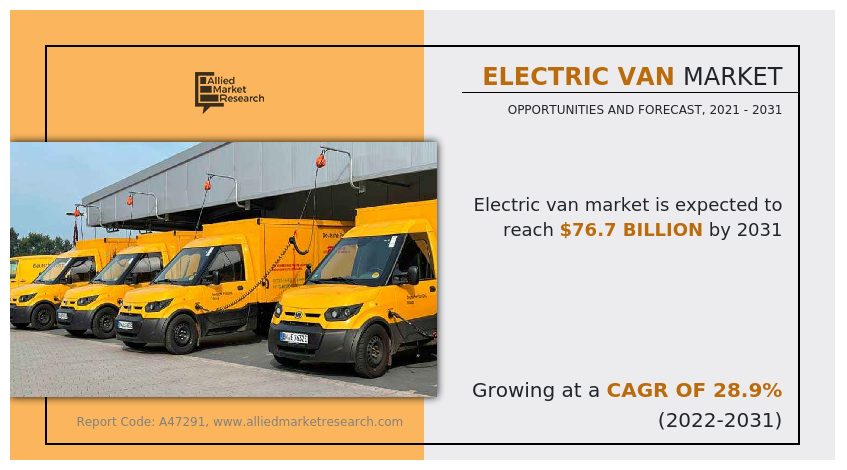Allied Market Research published a report, titled, “Electric Van Market by Range (Up to 100 miles, 100 to 200 miles, above 200 miles), by Battery Capacity (Up to 50 kWh, above 50 kWh), by Propulsion (Battery Electric Van, Plug-in Hybrid Electric Van), and by Application (Personal, Commercial): Global Opportunity Analysis and Industry Forecast, 2021- 2031”. According to the report, the global electric van industry generated $6.1 billion in 2021 and is anticipated to generate $76.7 billion by 2031, witnessing a CAGR of 28.9% from 2022 to 2031.
𝐑𝐞𝐪𝐮𝐞𝐬𝐭 𝐒𝐚𝐦𝐩𝐥𝐞 𝐏𝐚𝐠𝐞𝐬- https://www.alliedmarketresearch.com/request-sample/47765
Prime determinants of growth
The increase in government initiatives for the promotion of e-mobility, the increase in demand for emission-free & high-performance electric vans, and the reduction in the cost of electric vehicle batteries drive the growth of the global electric van market. However, the lack of charging infrastructure, and limited range of electric vans restrict the market growth. Moreover, technological advancements are expected to present new opportunities in the coming years.

Covid-19 Scenario
- The outbreak of the Covid-19 pandemic had a negative impact on the global electric van market.
- The pandemic resulted in the shutdown of several electric van manufacturing facilities across the globe. Manufacturers faced a shortage in the supply of automobile-related components such as semiconductor chips.
The 100 to 200 miles segment to maintain its leadership status throughout the forecast period
Based on range, the 100 to 200 miles segment held the highest market share in 2021, accounting for more than half of the global electric van market, and is estimated to maintain its leadership status throughout the forecast period. The launch of new electric vans having a range between 100 to 200 miles contributes to the growth of the market. For instance, in April 2021, Fiat Professional, a Stellantis NV subsidiary, unveiled its new 100% electric “E-Ducato” van. Moreover, the 100 to 200 miles segment is projected to manifest the highest CAGR of 29.4% from 2022 to 2031.
The above 50 kWh segment to maintain its leadership status throughout the forecast period
Based on battery capacity, the above 50 kWh segment held the highest market share in 2021, accounting for nearly 59% of the global electric van market, and is estimated to maintain its leadership status throughout the forecast period. Electric vans with a battery capacity of more than 50 kWh are used in commercial operations. The large share of this segment is mainly attributed to the increasing application of electric vans in the logistics sector, and last-mile deliveries. Moreover, the above 50 kWh segment is projected to manifest the highest CAGR of 29.4% from 2022 to 2031.
𝐏𝐫𝐨𝐜𝐮𝐫𝐞 𝐂𝐨𝐦𝐩𝐥𝐞𝐭𝐞 𝐑𝐞𝐬𝐞𝐚𝐫𝐜𝐡 𝐑𝐞𝐩𝐨𝐫𝐭 – https://www.alliedmarketresearch.com/electric-van-market/purchase-options
The battery electric van segment to maintain its lead position during the forecast period
Based on propulsion, the battery electric van segment accounted for the largest share in 2021, contributing to more than 95% of the global electric van market, and is projected to maintain its lead position during the forecast period. This is attributed to simple technology usage and low maintenance of battery electric vans as compared to other electric vehicles. In addition, the launch of a new battery electric van contributes to the growth of this segment. For instance, in September 2021, Nissan introduced its new electric van namely, “Townstar”. It utilizes a single electric motor that produces 122 horsepower and an instant torque of 245 nm. Moreover, the battery electric van segment is expected to portray the largest CAGR of 29.1% from 2022 to 2031.
The commercial segment to maintain its leadership status throughout the forecast period
Based on application, the commercial segment held the highest market share in 2021, accounting for more than half of the global electric van market, and is estimated to maintain its leadership status throughout the forecast period. The adoption of electric vans by logistics companies to reduce their carbon footprints supplements the market growth. Moreover, the commercial segment is projected to manifest the highest CAGR of 29.2% from 2022 to 2031.
Asia-Pacific to maintain its dominance by 2031
Based on region, Asia-Pacific held the highest market share in terms of revenue in 2021, accounting for more than half of the global electric van market, and is likely to dominate the market during the forecast period. The adoption of electric vans owing to government regulations, and the higher adoption rate of smart mobility services, boost the growth of the electric van market in the Asia-Pacific region. In addition, the introduction of new electric vans by the market players in the region supplements the market growth. Moreover, the Asia-Pacific region is expected to witness the fastest CAGR of 29.8% from 2022 to 2031.
𝐈𝐧𝐪𝐮𝐢𝐫𝐲 𝐁𝐞𝐟𝐨𝐫𝐞 𝐁𝐮𝐲𝐢𝐧𝐠- https://www.alliedmarketresearch.com/purchase-enquiry/47765
Leading Market Players: –
- BYD Company Ltd
- Ford Motor Company
- General Motors Company
- Mercedes-Benz Group AG
- Nissan Motor Co., Ltd.
- Renault S.A.
- Stellantis NV
- Toyota Motor Corporation
- Volkswagen AG
- Workhorse Group Inc.